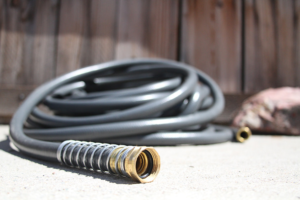
Drain, remove, and store outdoor hoses before winter. ATTRIBUTION: Your Best Digs (Flickr)
Each year in the United States, an average of 250,000 homes sustain water damage caused by pipes that freeze and burst. If you live in a cold climate, frozen pipes are more common than you think, especially when you consider that water freezes at just 32 degrees Fahrenheit. While indoor pipes are protected from the elements, the onset of freezing can occur when outdoor temperatures fall to 20 degrees Fahrenheit or below. Pipes in certain areas of your home may also be more susceptible to damage, such as water pipes found in unheated rooms like the garage or basement. Pipes found outdoors are especially vulnerable to freezing, as most are not well-protected from ice buildup and wind chill.
One of the best things you can do to prevent frozen pipes is to better insulate your home. Under-insulated walls can allow drafts to enter your house, which not only affects the state of your pipes but also your energy bills. But each fall, I also consider several essential tasks to prepare my home and the pipes for the winter ahead. While it doesn’t often get that cold where I live, it’s better to be safe than sorry!
Keep the Heat On While You’re Away
Many homeowners make the mistake of turning off their heat while they’re away on vacation. While this can save you a few bucks in heating costs, you risk your pipes freezing and bursting, which can result in hundreds to thousands of dollars in repair costs. While you’re away from home for extended periods of time, set your thermostat above 50 degrees Fahrenheit.
Drain and Remove Outdoor Hoses
Don’t forget to remove, drain, and store any outdoor hoses before winter strikes. Close inside supply valves that supply outdoor hose bibbs. Open outside hose bibbs to allow any remaining water in the pipes to drain. Water left in hoses and pipes can freeze and expand, causing them to break.
Apply Extra Insulation to Pipes
Pipes located in unheated areas of the home, such as basements and attics, may need additional insulation to keep them from freezing. Most pipes can be fitted with fiberglass or rubber sleeves to help keep them warm. Pipes that are easily accessible can also be wrapped in electrical heating tape applied directly to the pipe.
Seal Up Cracks and Holes
Properly seal up cracks, holes, or gaps found in exterior and interior walls. Caulking openings near pipes can help prevent cold air from entering and warm air from escaping. Also take the time to caulk or weather-strip around doors and windows, especially those found in your attic and basement.
Open Kitchen and Bathroom Cabinet Doors
During cold snaps, open kitchen and bathroom cabinet doors to allow warm air to circulate around the pipes. If your pipes are in the early stages of freezing, use a hair dryer or heating pad wrapped around the pipes to help them thaw. If you know it’s going to be extremely cold, allow a small trickle of water to run from your faucets at night.
